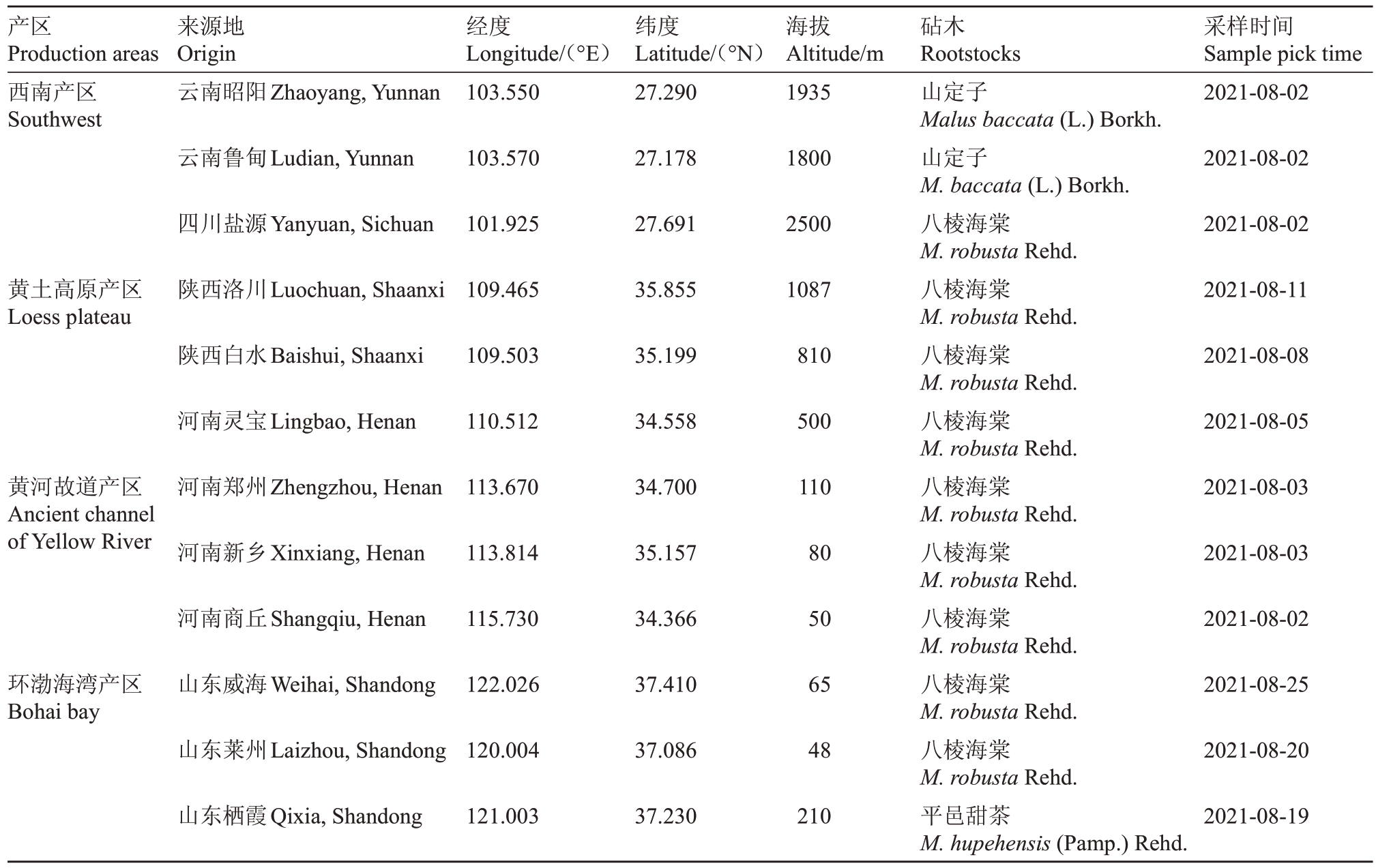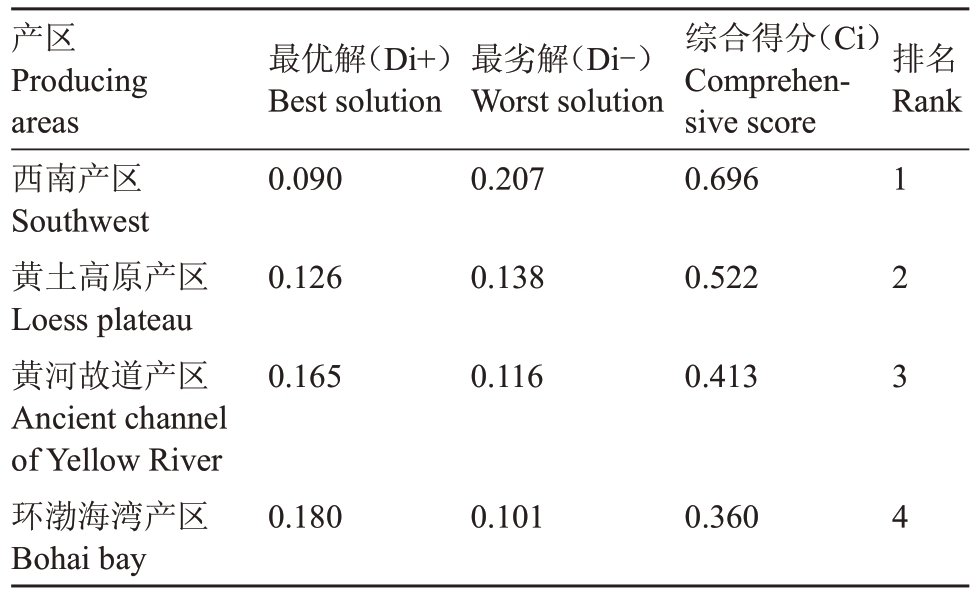苹果作为中国第一大水果,无论是种植面积还是产量均居水果之首[1-2],中国也是世界最大的苹果生产和消费国家[3]。随着科学技术进步和发展变迁,形成了西南冷凉高地、环渤海湾、黄河故道和黄土高原4个苹果主要产区[4],不同产区不同品种果实品质表现各有特色,即使同一品种的不同产区果实品质也差异明显。目前,我国苹果品种结构不合理,以红富士为主的晚熟品种约占70%,早中熟品种严重不足,华硕作为中国自主选育的优良早熟品种,在我国主要产区栽培表现为适应性良好、结果早、产量高及抗病性强等特点,可作为早中熟品种推广发展[5-6]。苹果品质评价已成为苹果品种选育、种植布局以及提升食用安全水平、营养价值、市场核心竞争力的重要依据。关于富士、嘎拉、国光等“老品种”品质评价研究报道较多[7-9],对于我国自主知识产权优良品种,特别是早中熟品种在不同产区品质评价的研究甚少。笔者通过对不同产区的华硕苹果的果实品质差异性进行分析,寻找不同产区品种特色,将为优良品种区域适应性研究、种植布局及结构调整提供学术理论参考,也可以为各产区制定品质提升的农艺措施提供参考。
长期以来,果树科研工作者对果实品质的定性、定量分析进行了大量探索与实践。不同品种间的品质比较方面,聂继云等[7]、徐吉花等[8]对苹果理化品质评价指标(因子)进行选择研究;汤卫东等[10]应用模糊综合评判法对苹果感官品质开展了模糊综合评价研究;王海波等[11]对几个早熟苹果品种果实糖酸组分及风味品质进行评价;李卓等[12]对8 个不同产地长富2号苹果品质差异及地理坐标的相关性进行研究。以上研究主要集中在确立不同品种果实品质的简化评价指标,或者探索主要评价指标的关系方面,为了解不同产地苹果品质差异和地理分布提供了宝贵的信息,为开展本研究提供了有益的参考和启示。然而,应用多个指标对特定品种在不同产区的综合品质差异进行系统全面的品质比较分析,这方面的研究报道相对较少。为了避免人为干预和评价指标的量纲、样本数量对评价结果的影响,笔者结合前人研究成果,在对我国4 个主要产区华硕苹果外观、质地和理化等共17个指标检测基础上,通过F检验、双侧t检验、变异系数权重法等统计分析,对华硕进行深入、客观、科学评价和定量、定性分析比较,探明各产区品质指标差异,同时,利用TOPSⅠS 法(优劣解距离法)对归一化处理结果进行比较与排序,为提高苹果品质、精准指导优良品种区域布局及结构调整提供参考。
1 材料和方法
1.1 样品采集地点、时间及处理方法
样品采集自西南冷凉高地产区(以下简称西南产区)、黄土高原产区、黄河故道产区和环渤海湾产区,每一产区选取树龄相近的3 个乔化模式种植的8~10 年生具有代表性的华硕苹果园,其中,西南产区云南昭阳和鲁甸砧木为本地山定子,山东栖霞砧木为平邑甜茶,其他产区均为八棱海棠(表1)。因地理条件差异,本次样品采样时间在2021 年8月初至8月中下旬,西南产区采收最早,环渤海湾产区最晚(表1)。为尽量体现各产区华硕苹果品质和减少因采收时间不同对品质的影响,成熟度采用淀粉指数法测定,淀粉指数统一在8.5~9.5之间。样品采集后,首先进行外观等品质指标测定,然后将样品切块,于液氮中速冻后-80 ℃保存,检测相关指标。每个指标测定分3组生物学重复,每组测定10个苹果。
表1 华硕苹果采集地信息
Table 1 Huashuo apple collects information on where it was collected

产区Production areas西南产区Southwest来源地Origin云南昭阳Zhaoyang,Yunnan经度Longitude/(°E)103.550纬度Latitude/(°N)27.290海拔Altitude/m 1935采样时间Sample pick time 2021-08-02云南鲁甸Ludian,Yunnan 103.570 27.178 1800 2021-08-02四川盐源Yanyuan,Sichuan 101.925 27.691 2500 2021-08-02黄土高原产区Loess plateau陕西洛川Luochuan,Shaanxi 109.465 35.855 1087 2021-08-11陕西白水Baishui,Shaanxi 109.503 35.199 810 2021-08-08河南灵宝Lingbao,Henan 110.512 34.558 500 2021-08-05黄河故道产区Ancient channel of Yellow River河南郑州Zhengzhou,Henan 113.670 34.700 110 2021-08-03河南新乡Xinxiang,Henan 113.814 35.157 80 2021-08-03河南商丘Shangqiu,Henan 115.730 34.366 50 2021-08-02环渤海湾产区Bohai bay山东威海Weihai,Shandong 122.026 37.410 65 2021-08-25山东莱州Laizhou,Shandong 120.004 37.086 48 2021-08-20山东栖霞Qixia,Shandong 121.003 37.230 210砧木Rootstocks山定子Malus baccata(L.)Borkh.山定子M.baccata(L.)Borkh.八棱海棠M.robusta Rehd.八棱海棠M.robusta Rehd.八棱海棠M.robusta Rehd.八棱海棠M.robusta Rehd.八棱海棠M.robusta Rehd.八棱海棠M.robusta Rehd.八棱海棠M.robusta Rehd.八棱海棠M.robusta Rehd.八棱海棠M.robusta Rehd.平邑甜茶M.hupehensis(Pamp.)Rehd.2021-08-19
1.2 测定项目及方法
用游标卡尺测定果实纵径和横径,果形指数为纵径与横径之比;采用色差计(KONⅠCA,CM-600)测定色泽,测定方法:将果实沿赤道部均匀分成5个部分,测定每个部分中心点的色差数值,记录色差a值;用质构仪(Food Technology Corporation,TMSTOUCH)测定果实质地,包括破裂力(N)、硬度(N)、最大黏附力(N)、黏附性(N ∙mm)、内聚性、弹性(mm)、胶黏性(N)7项指标,弹性与胶黏性数值乘积为咀嚼性(mj);用手持糖度计(日本爱拓,PAL-1)测定可溶性固形物含量[13];采用2,6-二氯靛酚滴定法测定维生素C含量[14]。
用气相色谱质谱(GC-MS)法测定果糖、总糖、总酸含量,参考文献[15-16]方法,采用DB-5MS毛细管柱(5%苯基/甲基聚硅氧烷,30 m×0.25 mm×0.25 μm,Agilent Technologines),扫描范围45~600 m ∙z-1,进样口温度230 ℃,传输线温度250 ℃,离子源温度230 ℃;载气为高纯氦气(99.999%),载气流量1.0 mL ∙min-1;程序升温70 ℃开始,保持5 min,以5 ℃∙min-1 升至260 ℃,保持15 min;溶剂延迟为5 min;分流比为20∶1;自动进样量为1µL。将试验所得到的质谱图与NⅠST 2016数据库中的标准谱图以及标准品谱图进行比对,得到极性代谢物的初步定性分析结果。剔除结果中的柱流失及相对峰面积<2%的成分,其次剔除重复数<3的成分,再次根据保留时间和选择离子碎片信息进行定量分析。
糖酸比为总糖含量除以总酸含量数值。采用马志本等[17]和霍琳琳等[18]方法测定花色苷含量,用甲醇提取果实中花色苷后,在530 nm 处测吸收峰,按照下式计算花色苷含量:
式中:V 为提取液总体积;n 为稀释倍数;M 为(矢车菊素3-葡萄糖苷分子质量)449.4;△为消光系数(29 600 L∙cm-1∙mg-1);m为样品质量(g)。
1.3 分析方法
据报道,果树科学试验中正态分布是最常见的分布和服从正态分布的样本能获得理想的分级结果[7,19],在4 个产区的品质指标服从正态分布基础上,采用F 检验逐一比较产区间的单个品质指标差异显著性,采用双侧t 检验比较任意两个产区间的单个品质指标差异显著性;采用变异系数权重法对外观、质地、营养3 类性状进行分类评分,品质性状权重得分为测定值×权重系数,其中,权重系数采用正向标准化方法计算;各类品质性状权重得分之和为该类性状总得分,总得分越高,品质越佳;采用TOPSⅠS法对4个产区华硕苹果进行整体综合评价,最优解Di+越接近0、最劣解Di-越接近1、综合得分Ci越接近1,评价越好。
1.4 数据处理
在Excel 中整理品质指标测定数据,计算各品质指标的权重、指标得分及综合品质得分,在SPSS中进行F检验、双侧t检验相关性分析。
2 结果与分析
2.1 不同产区华硕苹果果实品质比较分析
聂继云[20]认为单果质量作为评价标准,会严重误导经营者和消费者,故笔者在本研究中在对4 个产区华硕苹果的外观、质地和营养理化共17项果实品质指标检测分析时,未将单果质量列为评价指标。通过表2的品质指标数据,结合《苹果品质指标评价规范》(NY/T 2316—2013)[21]和《鲜苹果》(GB/T10651—2008)[22]进行比较分析,结果表明,华硕果形指数均在0.85以上,果形高桩端正,可溶性固形物含量(w,后同)在(12.30±0.60)%~(13.60±0.30)%,为中等级别,硬度和维生素C含量指标相对偏低。
表2 不同产区华硕苹果品质指标F 检验分析
Table 2 F-test analysis of quality indicators for Huashuo apples in different production areas

注:*表示不同产地的品质指标在0.05 水平差异显著(t 检验)。
Note:*indicates that quality indicators in different production areas is significantly different at p ≤0.05(t-test).
比酸糖Sugaracid ratio 36.20±2.20 43.60±8.20酸)w(总Total acid content/(mg∙g-1)2.46±0.25 2.24±0.31糖)w(总Total sugar content/88.50±3.40 95.00±4.90糖)(mg∙g-1)w(果Fructose content/(mg∙g-1)61.40±3.70 64.80±1.90苷)w(花色yanin content/Anthoc-(mg∙g-1)0.42±0.11 0.41±0.06生素content/指标w(维Vitamin C(mg∙100 g-1)2.12±0.38 1.11±C)0.18理溶化物)养营Nutritional physicochemical indicators性w(可形固Soluble solids content/%12.90±0.70 13.60±0.30性嚼2.70 0.80咀Chewiness/mj 56.30±43.30±性黏胶Gumminess/N 11.00±0.70 10.70±0.60性弹Springines/mm 5.90±0.50 4.70±0.40内Cohesive-聚ness性0.16±0.01 0.16±0.01性附黏Adhesiveness/(N∙mm)5.50±0.60 4.20±1.90黏大力最附Adhesive force/N-2.40±0.10-2.10±0.40硬Hardness/度N 67.70±2.20 67.60±1.60地裂力质Texture破Fracture/N 57.80±0.90 60.10±1.60颜Appearance Fruit surface colors面a值果色a value 30.60±4.80 23.70±4.80观外果指Fruit形数shape index 0.91±0.02 0.90±0.02区产区南区土原产Production areas西产Southwest黄高Loess plateau 55.30±6.50 34.80±0.70 42.60±9.30 1.87±0.21 2.72±0.22 2.30±0.30 102.00±0.80 94.80±8.30 94.20±5.80 63.60±1.20 61.70±5.60 62.20±2.60 0.35±0.10 0.37±0.04 0.37±0.05 1.29±0.12 1.61±0.34 1.51±0.44 12.30±0.60 12.40±0.20 12.70±0.70 36.30±9.00 33.10±5.60 42.30±10.30 10.50±0.60 8.10±0.40 10.10±1.30 4.70±0.70 4.40±0.80 4.90±0.70 0.15±0.02 0.13±0.01 0.15±0.01 4.00±1.40 4.00±1.00 4.40±0.80-2.00±0.30-2.10±0.50-2.10±0.20 68.10±4.40 59.80±2.20 65.80±4.00 60.90±1.80 55.30±2.00 58.50±2.50 9.20±10.00 19.50±0.70 20.90±8.90 0.93±0.02 0.94±0.02 0.92±0.02区区产产值河道渤湾平Mean Ancient channel of Yellow River Bohai bay均黄故环海6.141 0.018*4.074 0.050*2.318 0.152 0.431 0.737 0.245 0.863 5.166 0.028*2.907 0.101 4.852 0.033*3.994 0.052 1.918 0.205 2.359 0.148 0.62 0.621 0.678 0.590 2.236 0.161 1.783 0.228 5.248 0.027*1.195 0.372 Fp
表2 F检验结果表明:4个产区华硕苹果的17项品质指标中,果面颜色a值、咀嚼性、维生素C含量、总酸含量和糖酸比5项指标的p值均小于等于0.05,表明不同产区间这5 项品质指标差异显著,受产地影响较大,其余12项品质指标差异不显著。
不同产区华硕苹果品质指标双侧t 检验结果(表3)表明,西南产区果面颜色a 值最高为30.6,其次为黄土高原产区23.7,环渤海湾产区为19.5,黄河故道产区最低为9.2。西南产区果面颜色a 值指标极显著高于环渤海湾产区、显著高于黄河故道产区。
表3 不同产区华硕苹果品质指标双侧t 检验分析
Table 3 Bilateral t-test analysis of quality indicator of Huashuo apples in different production areas

注:*.通过≤0.05 显著性检验;**.通过≤0.01 显著性检验。
Note:*.Pass the significance test ≤0.05;**.Pass significance test ≤0.01.
糖Sugar-比酸acid ratio 0.284 0.017 0.498 0.189 0.143 0.004**总Total acid量含酸content 0.471 0.063 0.586 0.243 0.227 0.024*总含Total糖量sugar content 0.197 0.006**0.676 0.120 0.624 0.155果Fructose量含糖content 0.303 0.470 0.651 0.470 0.269 0.367苷花Anthocyanin量含色content 0.917 0.593 0.353 0.560 0.308 0.697素C生量维含Vitamin content 0.026*0.042*0.119 0.295 0.148 0.356溶物固量可形性含Soluble solids content 0.249 0.415 0.218 0.065 0.024*0.707性咀Chewiness 0.003**嚼0.040*0.013*0.333 0.087 0.366胶Gumminess黏性0.665 0.473 0.075 0.751 0.089 0.100弹Springines 0.067性0.107 0.081 0.926 0.321 0.359内Cohesiveness聚性0.895 0.676 0.164 0.716 0.168 0.218黏Adhesiveness性附0.408 0.245 0.075 0.928 0.685 0.723黏大力最附Adhesive force 0.358 0.194 0.308 0.735 0.445 0.514硬Hardness度0.969 0.925 0.239 0.903 0.240 0.236破Fracture力裂0.152 0.094 0.357 0.642 0.295 0.275色颜面果a值Fruit surface colors a value 0.109 0.038*0.000**0.136 0.273 0.127果指Fruit形数shape index 0.756 0.448 0.392 0.126 0.147 Ancient channel 0.908///区区 区区区/产/产产/产产产产Production产产区道原湾区原区湾道湾高故产故areas高海产高故海产海Southwest/南渤 土河Southwest/南河Loess plateau区土渤区区Bohai bay南土河渤Southwest/原道区西黄 西黄of Yellow River西环 黄黄Loess plateau/Ancient channel of Yellow River黄环Loess plateau/Bohai bay黄环Ancient channel of Yellow River/Bohai bay
西南产区华硕苹果咀嚼性最高为56.30 mj,其次为黄土高原产区43.30 mj,黄河故道产区和环渤海湾产区相对较低,分别为36.30 mj 和33.10 mj,双侧t 检验结果表明西南产区华硕苹果咀嚼性极显著高于黄土高原产区,显著高于黄河故道产区和环渤海湾产区。
4个产区华硕苹果的7项营养理化指标中,花色苷和果糖含量不同产区间差异不显著。西南产区的维生素C含量最高为2.12 mg∙100 g-1,显著高于黄土高原产区和黄河故道产区,其余各产区维生素C含量依次为环渤海湾产区1.61 mg∙100 g-1、黄河故道产区1.29 mg∙100 g-1和黄土高原产区1.11 mg∙100 g-1。4个产区可溶性固形物含量除黄土高原产区的较高,为13.6%,显著高于环渤海湾产区,其余产区均低于13.0%,且无显著差异。黄河故道产区总糖含量最高为102 mg∙g-1,极显著高于西南产区,总酸含量最低为1.87 mg∙g-1,显著低于环渤海湾产区,其余各产区间总糖和总酸含量均无显著差异。黄河故道产区由于总糖含量最高,总酸含量最低,故糖酸比最高为55.30,极显著高于环渤海湾产区,其余各产区糖酸比为黄土高原产区43.60>西南产区36.20>环渤海湾产区34.80,4 个产区华硕苹果的糖酸比均在30~60 之间,研究表明苹果果实糖酸比在20~60 之间多为酸甜适宜[23],表明这4 个产区的华硕苹果果实酸甜可口,品质较好。
笔者在本研究中通过对4个产区的华硕苹果果实外观、质地及营养理化共17 项品质指标测定,结果表明华硕作为早熟品种,在以上4个产区,具有颜色鲜艳、果形端正、酸甜适宜等诸多优势,不失为一个早熟优良品种。
2.2 基于变异系数权重法对4个产区华硕苹果综合品质评价
通过变异系数权重法将外观、质地、营养3类品质指标分类评分和权重评分(表4),从计算结果可以看出,西南产区的外观品质性状评分1.761 为最优,其余产区为黄土高原产区1.377>环渤海湾产区1.176>黄河故道产区0.569;西南产区的质地品质性状评分11.509 为最优,其余产区为黄土高原产区10.675>黄河故道产区10.298>环渤海湾产区7.272;黄河故道产区营养理化品质性状的评分14.674 为最优,其余产区为黄土高原产区13.610>西南产区12.534>环渤海湾产区12.417。西南产区的综合品质评价评分25.804 为最优,其余产区为黄土高原产区25.662>黄河故道产区25.541>环渤海湾产区20.865。
表4 变异系数权重法评分结果
Table 4 The scoring results of coefficient of variation weighting method

合Total计25.804 12.534得Score分糖Sugar-比ratio acid酸2.483 acid总含Total酸量content Fructose 0.137果含糖量content 5.474糖量营Nutritional physicochemical indicators sugar总含Total content 3.468花含苷Anthocyanin色量content 0.024 C素指生量标Vitamin维含content 0.135理化性含固量溶物养可形Soluble solids content 0.813分得Score 11.509性嚼咀Chewiness 3.318胶Gumm-黏iness性0.589弹Spring-性iness 0.340内Cohesi-性聚黏Adhesivveness 0.008性附eness 0.358黏大力最附Adhesive硬Hardness force 0.148度3.636质Texture破Fracture力地裂3.112得Score分1.761外Appearance颜面a值果色Fruit surfacecolors a value 1.708观果指Fruit形数shape index 0.053产Production区产区areas西Southwest南25.662 25.541 13.610 14.674 2.991 3.794 0.124 0.104 5.879 6.307 3.664 3.592 0.023 0.020 0.071 0.082 0.858 0.775 10.675 10.298 2.553 2.140 0.574 0.563 0.270 0.267 0.008 0.008 0.273 0.262 0.131 0.124 3.631 3.654 3.235 3.280 1.377 0.569 1.324 0.514 0.053 0.055原道高黄产Loess故土区plateau河区黄产Ancient channel ofYellow River 20.865 12.417 2.411 0.069 0.145 0.056 5.655 0.062 3.329 0.057 0.018 0.057 0.098 0.064 0.761 0.063 7.272 1.596 0.059 0.345 0.054 0.203 0.057 0.006 0.054 0.234 0.065 0.083 0.063 2.493 0.054 2.312 0.054 1.176 1.121 0.056 0.055 0.059湾数海系渤区重环产Bohai bay权Weight coefficient
2.3 基于TOPSIS法对4个产区华硕苹果综合品质评价
TOPSⅠS 法评分结果表明(表5),华硕苹果综合品质性状4个产区中西南产区最优解Di+=0.090,更接近0,最劣解Di-=0.207,更接近1,综合评分Ci=0.696,位列第一,其次为黄土高原产区,位列第二,黄河故道产区和环渤海湾产区依次位列第三和第四。这与变异系数权重法评分结果一致。
表5 TOPSIS 评分结果
Table 5 The scoring results of TOPSIS

产区Producing areas西南产区Southwest黄土高原产区Loess plateau黄河故道产区Ancient channel of Yellow River环渤海湾产区Bohai bay最优解(Di+)Best solution 0.090最劣解(Di-)Worst solution 0.207综合得分(Ci)Comprehensive score 0.696排名Rank 0.126 0.138 0.522 0.165 0.116 0.413 0.180 0.101 0.360 1 2 3 4
3 讨 论
在苹果评价中应用的综合评价方法主要有主成分法、模糊评价法和灰色关联度分析法。汤卫东等[10]用模糊评价法评价苹果感官品质,该方法在一定程度上依赖于专家经验。白沙沙等[24]利用主成分分析法对辽宁兴城的53个苹果品种进行评价,该方法以各主成分相应的方差贡献率作为权重,优点是避免人为赋予权重造成影响,缺点是只能反映原有品质性状的绝大部分信息,而不是全部信息。而笔者在本研究中采用的TOPSⅠS法是将原始指标归一化处理结果进行对比和排序,优点是归一化处理使所有指标处于相似的尺度,各指标的权重反映在计算综合指数期间,既不损失原始指标信息,也不会因异值影响输出结果,在各行业中应用广泛[25-27],不足之处是需借助其他方法确定权重,不同的权重可能得出不同的结果。借助变异系数权重法客观赋权,笔者用TOPSⅠS 法解出最优解和最劣解,克服了诸多主观因素的影响,客观定量分析了我国不同产区华硕苹果果实综合品质,可全面地反映华硕苹果品质的优劣。
研究表明4个产区华硕苹果除了基于变异系数权重法分类评价差异不显著外,F 检验、双侧t 检验和TOPSⅠS 法评价都显示不同指标和程度上的差异。其中,西南产区的果面颜色a 值极显著高于环渤海湾产区、显著高于黄河故道产区;西南产区的外观品质性状评分最优,其次为黄土高原产区,环渤海湾和黄河故道两个产区评分较低。果面颜色a值作为以红色为主的重要指标,参照路绪强等[28]的研究结果,采用色差仪进行果面颜色a值测定,具有检测速度快、成本低的优点,有其科学性与实用性;研究结果也与刘志容等[29]海拔越高越有利于苹果果实着色的研究结果具有高度的一致性,但果面颜色a 值与海拔以及相关地理、气候指标的关联性仍需进一步研究。在8 项质地指标中,仅咀嚼性在不同产区间存在显著差异,西南产区极显著高于黄土高原产区、显著高于黄河故道和渤海湾产区。咀嚼性是硬度、内聚性和弹性的乘积[30],作为一项复合指标,研究结果中咀嚼性显著差异是否可以作为质地指标的代表性评价指标尚待进一步研究。在7项营养理化指标中,除花色苷和果糖含量在不同产区间无显著差异外,其余5 项指标在不同产区间均存在显著差异,其中,西南产区的维生素C含量显著高于黄土高原产区和黄河故道产区,黄土高原产区的可溶性固形物含量显著高于环渤海湾产区,西南产区的总糖含量极显著低于黄河故道产区,黄河故道产区的总酸含量显著低于环渤海湾产区等,这些差异及指标的确立,为果实风味、色泽以及口感等品质评价指标选择、区域特色及功能苹果品种开发提供一定的理论支撑。
从变异系数权重法和TOPSⅠS 法评价结果来看,4 个产区华硕苹果品质综合评分由高到低依次为西南产区、黄土高原产区、黄河故道产区和环渤海湾产区,两种评价方法结果具有高度的一致性,综合前人研究结果,4 个产区种植地海拔也显示了由高到低的一致性[29,31-32],说明高海拔地区更有利于着色品种的外观品质形成,但从品质评分的角度考虑,果面颜色a值与海拔由高到低的一致性关联影响尚有待进一步细化研究。此外,笔者在本研究中选取黄河故道、环渤海湾、黄土高原和西南4个产区的华硕苹果,采样时为最大限度确保苹果的品质差异来源于产地因素,选取了果园栽培管理水平基本一致,且在各产区华硕苹果适采成熟期进行采样,虽然考虑了乔化种植模式及树龄等的相似或一致性,但因地域及栽培习惯的不同,砧木或砧穗组合无法做到完全一致,加之一个品种品质的形成,还受产地光照、土壤条件、气温、积温以及栽培管理水平等诸多因素的影响,研究的细致和深入程度显然不够,尚有待今后进一步探索研究。
4 结 论
果面颜色a 值、咀嚼性、维生素C 含量、总酸含量、糖酸比等5 项指标在不同产区间差异显著。变异系数权重法分类评价差异不显著。权重系数法总体评价和TOPSⅠS 法综合评价,华硕苹果品质由高到低依次为西南产区、黄土高原产区、黄河故道产区和环渤海湾产区。高海拔的西南产区和黄土高原产区更有利于华硕品种优势和特色的发挥。
[1] 聂继云.苹果的营养与功能[J].保鲜与加工,2013,13(6):56-59.NⅠE Jiyun.Nutritional components of apple and their physiological functions to human health[J].Storage and Process,2013,13(6):56-59.
[2] 贾朝爽,王志华.不同产地的12 个苹果品种品质指标数据集[J].农业大数据学报,2022,4(2):20-24.JⅠA Chaoshuang,WANG Zhihua.Quality index data set of 12 apple varieties from different habitats[J].Journal of Agricultural Big Data,2022,4(2):20-24.
[3] 霍学喜,刘天军,刘军弟,魏延安,姚心省,马晓燕,卢斐.2020年度中国苹果产业发展报告(精简版)[J].中国果菜,2022,42(2):1-6.HUO Xuexi,LⅠU Tianjun,LⅠU Jundi,WEⅠYan’an,YAO Xinsheng,MA Xiaoyan,LU Fei.China apple industry development report in 2020[J].China Fruit&Vegetable,2022,42(2):1-6.
[4] 国家苹果产业技术体系.中国现代农业产业可持续发展战略研究:苹果分册[M].北京:中国农业出版社,2017:9-10.National Apple Ⅰndustry Technology System.Research on the sustainable development strategy of China’s modern agricultural industry:Apple fascicle[M].Beijing:China Agriculture Press,2017:9-10.
[5] 阎振立,张恒涛,过国南,张顺妮,刘珍珍.苹果新品种华硕的选育[J].果树学报,2010,27(4):655-656.YAN Zhenli,ZHANG Hengtao,GUO Guonan,ZHANG Shunni,LⅠU Zhenzhen.Selection of a new early-ripening apple cultivar Huashuo[J].Journal of Fruit Science,2010,27(4):655-656.
[6] 阎振立,张恒涛,张瑞萍,刘珍珍,过国南.苹果新品种‘华硕’在我国14 个产地的表现[J].中国果树,2016(4):90-94.YAN Zhenli,ZHANG Hengtao,ZHANG Ruiping,LⅠU Zhenzhen,GUO Guonan.The performance of the new apple variety‘Huashuo’in 14 producing areas in China[J].China Fruits,2016(4):90-94.
[7] 聂继云,李志霞,李海飞,李静,王昆,毋永龙,徐国锋,闫震,吴锡,覃兴.苹果理化品质评价指标研究[J].中国农业科学,2012,45(14):2895-2903.NⅠE Jiyun,LⅠZhixia,LⅠHaifei,LⅠJing,WANG Kun,WU Yonglong,XU Guofeng,YAN Zhen,WU Xi,QⅠN Xing.Evaluation indices for apple physicochemical quality[J].Scientia Agricultura Sinica,2012,45(14):2895-2903.
[8] 徐吉花,赵政阳,王雷存,高华,刘振中,樊红科.苹果果实品质评价因子的选择研究[J].干旱地区农业研究,2011,29(6):269-274.XU Jihua,ZHAO Zhengyang,WANG Leicun,GAO Hua,LⅠU Zhenzhong,FAN Hongke.Selection of factors for apple fruit quality evaluation[J].Agricultural Research in the Arid Areas,2011,29(6):269-274.
[9] 张腊腊,韩明虎,胡浩斌,武芸,王丽朋.基于主成分分析的苹果品质综合评价[J].江苏农业科学,2020,48(3):209-213.ZHANG Lala,HAN Minghu,HU Haobin,WU Yun,WANG Lipeng.Comprehensive evaluation of apple quality based on principal component analysis[J].Jiangsu Agricultural Sciences,2020,48(3):209-213.
[10] 汤卫东,朱海涛,王建军,张淼.苹果感官品质的模糊综合评价[J].现代食品科技,2005,21(3):61-63.TANG Weidong,ZHU Haitao,WANG Jianjun,ZHANG Miao.Application of fuzzy synthetic evaluation to organoleptic quality evaluation of apple[J].Modern Food Science and Technology,2005,21(3):61-63.
[11] 王海波,陈学森,辛培刚,张小燕,慈志娟,石俊,张红.几个早熟苹果品种果实糖酸组分及风味品质的评价[J].果树学报,2007,24(4):513-516.WANG Haibo,CHEN Xuesen,XⅠN Peigang,ZHANG Xiaoyan,CⅠZhijuan,SHⅠJun,ZHANG Hong.Study on sugar and acid constituents in several early apple cultivars and evaluation of their flavor quality[J].Journal of Fruit Science,2007,24(4):513-516.
[12] 李卓,郭玉蓉,孙立军,刘婧琳,李景景,付成程.不同产地长富2 号苹果品质差异及其与地理坐标的相关性[J].陕西师范大学学报(自然科学版),2012,40(4):98-103.LⅠZhuo,GUO Yurong,SUN Lijun,LⅠU Jinglin,LⅠJingjing,FU Chengcheng.Quality differences of“Nagafu 2”apple from different habitats and its correlation with geographical coordinates[J].Journal of Shaanxi Normal University(Natural Science Edition),2012,40(4):98-103.
[13] 聂继云,闫震,李志霞.果品及其制品质量安全检测·营养品质和功能成分[M].北京:中国质检出版社,中国标准出版社,2017.NⅠE Jiyun,YANZhen,LⅠZhixia.Quality and safety testing of truits and their products ∙nutritional quality and functional components[M].Beijing:China Quality Ⅰnspection Press,Standards Press of China,2017.
[14] 中华人民共和国国家卫生和计划生育委员会.食品安全国家标准食品中抗坏血酸的测定:GB 5009.86—2016[S].北京:中国标准出版社,2017.National Health and Family Planning Commission of the People’s Republic of China.National food safety standard-Determination of ascorbic acid in food:GB 5009.86—2016[S].Beijing:Standards Press of China,2017.
[15] LⅠSEC J,SCHAUER N,KOPKA J,WⅠLLMⅠTZER L,FERNⅠE A R.Gas chromatography mass spectrometry-based metabolite profiling in plants[J].Nature Protocols,2006,1(1):387-396.
[16] ROESSNER U,WAGNER C,KOPKA J,TRETHEWEY R N,WⅠLLMⅠTZER L.Simultaneous analysis of metabolites in potato tuber by gas chromatography- mass spectrometry[J].The Plant Journal,2000,23(1):131-142.
[17] 马志本,程玉娥.关于苹果果实表面花青素含量的化学测定方法[J].中国果树,1984(4):49-51.MA Zhiben,CHENG Yu’e.Chemical determination method of anthocyanin content on apple fruit surface[J].China Fruits,1984(4):49-51.
[18] 霍琳琳,苏平,吕英华.分光光度法测定桑葚总花色苷含量的研究[J].酿酒,2005,32(4):88-89.HUO Linlin,SU Ping,LÜ Yinghua.Measurement of total anthocyanins in mulberry by UV-visible spectroscopy[J].Liquor Making,2005,32(4):88-89.
[19] 刘孟军.枣树数量性状的概率分级研究[J].园艺学报,1996,23(2):105-109.LⅠU Mengjun.Studies on the variations and probability gradings of major quantitative characters of Chinese jujube[J].Acta Horticulturae Sinica,1996,23(2):105-109.
[20] 聂继云.我国果品标准体系存在问题及对策研究[J].农产品质量与安全,2016(6):18-23.NⅠE Jiyun.Research on the existing problems and countermeasures of China’s fruit standard system[J].Quality and Safety of Agro-Products,2016(6):18-23.
[21] 中华人民共和国农业部.苹果品质指标评价规范:NY/T 2316—2013[S].北京:中国标准出版社,2013.Ministry of Agriculture of the People's Republic of China.Evaluation specification for quality indexes of apple:NY/T 2316—2013[S].Beijing:Standards Press of China,2013.
[22] 国家质量监督检验检疫总局,中国国家标准化管理委员会.鲜苹果:GB/T 10651—2008[S].北京:中国标准出版社,2008.General Administration of Quality Supervision,Ⅰnspection and Quarantine of the People's Republic of China,Standardization Administration of the People's Republic of China.Fresh apple:GB/T 10651—2008[S].Beijing:Standards Press of China,2008.
[23] 贾定贤,米文广,杨儒琳,陈素芬,张凤兰.苹果品种果实糖、酸含量的分级标准与风味的关系[J].园艺学报,1991,18(1):9-14.JⅠA Dingxian,MⅠ Wenguang,YANG Rulin,CHEN Sufen,ZHANG Fenglan.Sugar and acid content of fruit and its classification standard associated with flavor in different apple cultivars[J].Acta Horticulturae Sinica,1991,18(1):9-14.
[24] 白沙沙,毕金峰,王沛,公丽艳,王轩.基于主成分分析的苹果品质综合评价研究[J].食品科技,2012,37(1):54-57.BAⅠShasha,BⅠJinfeng,WANG Pei,GONG Liyan,WANG Xuan.Comprehensive evaluation of apple quality based on principal component analysis[J].Food Science and Technology,2012,37(1):54-57.
[25] 斯庆毕力格,毛斌.聚类分析和TOPSⅠS 法在森林资源综合评价中的应用[J].西北林学院学报,2016,31(4):241-245.SⅠQⅠNG Bilige,MAO Bin.Application of cluster analysis and TOPSⅠS method to the comprehensive evaluation of forest resources[J].Journal of Northwest Forestry University,2016,31(4):241-245.
[26] 孙振清,陈文倩,兰梓睿.基于熵权TOPSⅠS 法的区域绿色创新能力研究[J].企业经济,2019,38(2):20-26.SUN Zhenqing,CHEN Wenqian,LAN Zirui.Research on regional green innovation capability based on entropy weight TOPSⅠS method[J].Enterprise Economy,2019,38(2):20-26.
[27] 宁东贤,闫翠萍,赵玉坤,杨秀丽,杨丽萍,李楠,王镇.不同花生品种农艺、经济和品质性状TOPSⅠS 方法评价[J].山西农业科学,2018,46(12):1986-1989.NⅠNG Dongxian,YAN Cuiping,ZHAO Yukun,YANG Xiuli,YANG Liping,LⅠNan,WANG Zhen.Study on agronomic,economic and qualitative characters of different peanuts varieties with TOPSⅠS method evaluation[J].Journal of Shanxi Agricultural Sciences,2018,46(12):1986-1989.
[28] 路绪强,袁明,何楠,赵胜杰,朱红菊,刘文革.利用色差仪快速检测西瓜番茄红素含量[J].中国瓜菜,2021,34(4):41-45.LU Xuqiang,YUAN Ming,HE Nan,ZHAO Shengjie,ZHU Hongju,LⅠU Wenge.Rapid determination of watermelon lycopene content by using chromatic meter[J].China Cucurbits and Vegetables,2021,34(4):41-45.
[29] 刘志容,张光伦,冯绍玉,刘伟,冯绍惠,叶伟平.不同海拔高度光质分布与金冠苹果果实品质的相关性研究[J].北方园艺,2009(7):25-28.LⅠU Zhirong,ZHANG Guanglun,FENG Shaoyu,LⅠU Wei,FENG Shaohui,YE Weiping.Light quality distribution in different altitudes and its correlation with fruit quality of golden delicious apple tree[J].Northern Horticulture,2009(7):25-28.
[30] 潘秀娟,屠康.质构仪质地多面分析(TPA)方法对苹果采后质地变化的检测[J].农业工程学报,2005,21(3):166-170.PAN Xiujuan,TU Kang.Comparison of texture properties of post-harvested apples using texture profile analysis[J].Transactions of the Chinese Society of Agricultural Engineering,2005,21(3):166-170.
[31] 孙文泰,尹晓宁,刘兴禄,董铁,牛军强,马明.不同海拔高度对‘红富士’苹果果实品质的影响[J].北方园艺,2013(6):12-15.SUN Wentai,YⅠN Xiaoning,LⅠU Xinglu,DONG Tie,NⅠU Junqiang,MA Ming.Effect of different altitudes on quality of‘Red fuji’apple[J].Northern Horticulture,2013(6):12-15.
[32] 聂佩显,张守江,董伟,薛晓敏,王金政.不同海拔高度对天汪一号苹果果实品质的影响[J].落叶果树,2015,47(3):7-9.NⅠE Peixian,ZHANG Shoujiang,DONG Wei,XUE Xiaomin,WANG Jinzheng.The effect of different altitudes on the fruit quality of Tianwang No.1 apple[J].Deciduous Fruits,2015,47(3):7-9.